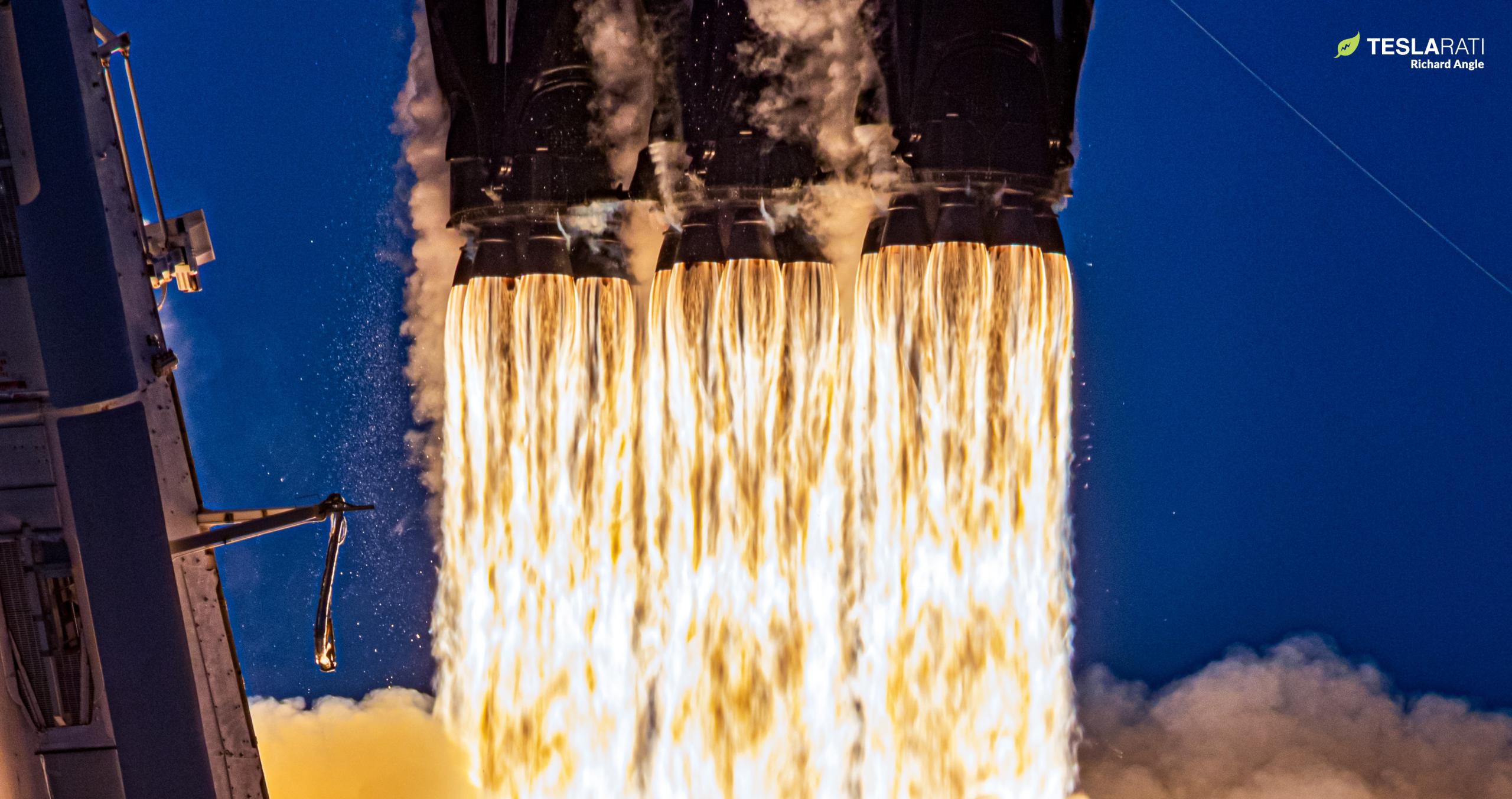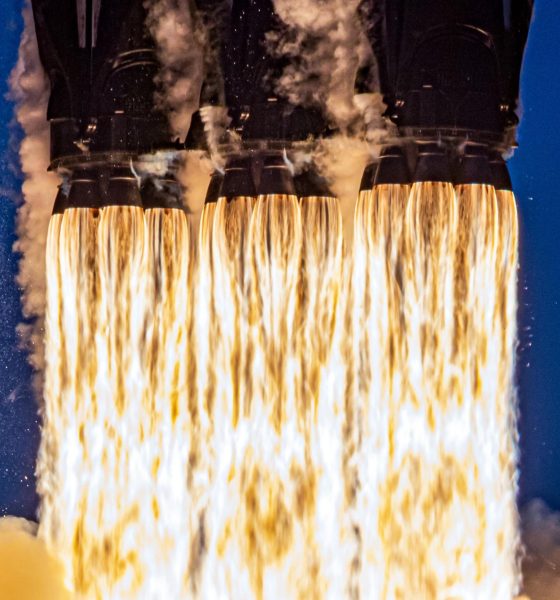

News
SpaceX executive forecasts 6 Falcon Heavy launches in 12 months
A SpaceX sales executive predicts that the company will launch Falcon Heavy, currently the most powerful operational rocket in the world, up to six times in the next 12 months.
Following years of delays and anticipation as SpaceX waited for the right moment to move forward with the massive rocket, Falcon Heavy debuted in February 2018 by launching CEO Elon Musk’s original Tesla Roadster into interplanetary space. The debut was nearly flawless and only marred by the loss of one of the rocket’s three first-stage boosters, which failed to touch down on a drone ship stationed in the Atlantic Ocean. In just a small taste of things to come, Falcon Heavy’s second launch followed 14 months later.
That April 2019 launch marked the rocket’s first commercial mission and sent a large communications satellite into an extra-energetic geostationary transfer orbit. Less than three months later, Falcon Heavy completed its third launch – a demonstration mission for the US Air Force. Such a quick turnaround raised hopes, but that optimism was unfortunately unfounded. 39 months later, it’s still hard to say when Falcon Heavy will finally launch for the fourth time.
Contrary to the connotations such a long gap between launches might evoke, Falcon Heavy’s manifest has grown at a respectable rate and currently sits at 11 launches. That includes two commercial satellite launches and three launches for the US military, but NASA (directly and indirectly) is by far SpaceX’s most eager Falcon Heavy customer with six firm launches booked and options for another two.
For years, however, all supposedly near-term Falcon Heavy launches have been more or less indefinitely delayed by payload problems. SpaceX has had no issues building and qualifying a huge amount of Falcon Heavy hardware for those missions, but the lack of payloads ready to fly has forced the company to find places to store all seven boosters – more than a third of its fleet – indefinitely.
That may finally change. Speaking on a panel at the 2022 World Satellite Business Week, SpaceX Vice President of Commercial Sales Tom Ochinero told the audience that the company has six Falcon Heavy launches scheduled in the next 12 months.
It’s possible that Falcon Heavy could end its launch hiatus and kick off that six-mission streak in the very near future. Spaceflight Now, a reliable source of launch schedules, recently updated its Launch Schedule to move Falcon Heavy’s USSF-44 mission up from late 2022 or 2023 to October 2022. Next Spaceflight, another reliable primary source, concurs. Both sources also agree that two additional missions (ViaSat-3 and USSF-67) could also launch this year.
For USSF-44 and ViaSat-3, Falcon Heavy will launch both sets of payloads directly into geostationary orbit – a type of mission SpaceX has never attempted. The rocket’s upper stage will need to survive a roughly six-hour coast in space and a trip through Earth’s radiation belts before firing up for a long burn to circularize its orbit around 36,000 kilometers (~22,300 mi) above the planet’s surface. To leave the upper stage with enough propellant for such a challenging task, SpaceX will intentionally expend one of Falcon Heavy’s three boosters during each launch. It remains to be seen which mission will launch first.
Given the history of all six of Falcon Heavy’s near-term missions, it’s safer to assume that the rocket isn’t going to launch at all in 2022 until a fully assembled vehicle has rolled out to the launch pad. For a late October launch, the USSF-44 payload(s) would need to arrive in Florida any day now, and SpaceX would need to start transporting Falcon Heavy boosters to Pad 39A’s integration hangar within a week or two to begin assembling the rocket. If that process begins, it’s likely that one or several of those distinct boosters will be spotted on their way to Pad 39A.
Including USSF-44, unofficial public manifests like Spaceflight Now and Next Spaceflight agree with Ochinero’s assertion that SpaceX has six Falcon Heavy missions tentatively scheduled in the next 12 months. Unspecified US military contractors are currently stumbling over themselves to prepare several satellites for launch: USSF-44 NET October 2022, USSF-67 NET December 2022, and USSF-52 NET April 2023. ViaSat and EchoStar contractors Boeing and Maxar are also struggling to prepare two massive commercial communications satellites for launches in November 2022 and January 2023. Finally, NASA’s Psyche asteroid explorer could be ready for its second launch attempt as early as July 2023 if the agency decides to proceed.
Delays are virtually guaranteed. Stay tuned for updates.

Elon Musk
Elon Musk’s X will start using a Tesla-like software update strategy
The initiative seems designed to accelerate updates to the social media platform, while maintaining maximum transparency.

Elon Musk’s social media platform X will adopt a Tesla-esque approach to software updates for its algorithm.
The initiative seems designed to accelerate updates to the social media platform, while maintaining maximum transparency.
X’s updates to its updates
As per Musk in a post on X, the social media company will be making a new algorithm to determine what organic and advertising posts are recommended to users. These updates would then be repeated every four weeks.
“We will make the new 𝕏 algorithm, including all code used to determine what organic and advertising posts are recommended to users, open source in 7 days. This will be repeated every 4 weeks, with comprehensive developer notes, to help you understand what changed,” Musk wrote in his post.
The initiative somewhat mirrors Tesla’s over-the-air update model, where vehicle software is regularly refined and pushed to users with detailed release notes. This should allow users to better understand the details of X’s every update and foster a healthy feedback loop for the social media platform.
xAI and X
X, formerly Twitter, has been acquired by Elon Musk’s artificial intelligence startup, xAI last year. Since then, xAI has seen a rapid rise in valuation. Following the company’s the company’s upsized $20 billion Series E funding round, estimates now suggest that xAI is worth tens about $230 to $235 billion. That’s several times larger than Tesla when Elon Musk received his controversial 2018 CEO Performance Award.
As per xAI, the Series E funding round attracted a diverse group of investors, including Valor Equity Partners, Stepstone Group, Fidelity Management & Research Company, Qatar Investment Authority, MGX, and Baron Capital Group, among others. Strategic partners NVIDIA and Cisco Investments also continued support for building the world’s largest GPU clusters.
News
Tesla FSD Supervised wins MotorTrend’s Best Driver Assistance Award
The decision marks a notable reversal for the publication from prior years, with judges citing major real-world improvements that pushed Tesla’s latest FSD software ahead of every competing ADAS system.

Tesla’s Full Self-Driving (Supervised) system has been named the best driver-assistance technology on the market, earning top honors at the 2026 MotorTrend Best Tech Awards.
The decision marks a notable reversal for the publication from prior years, with judges citing major real-world improvements that pushed Tesla’s latest FSD software ahead of every competing ADAS system. And it wasn’t even close.
MotorTrend reverses course
MotorTrend awarded Tesla FSD (Supervised) its 2026 Best Tech Driver Assistance title after extensive testing of the latest v14 software. The publication acknowledged that it had previously criticized earlier versions of FSD for erratic behavior and near-miss incidents, ultimately favoring rivals such as GM’s Super Cruise in earlier evaluations.
According to MotorTrend, the newest iteration of FSD resolved many of those shortcomings. Testers said v14 showed far smoother behavior in complex urban scenarios, including unprotected left turns, traffic circles, emergency vehicles, and dense city streets. While the system still requires constant driver supervision, judges concluded that no other advanced driver-assistance system currently matches its breadth of capability.
Unlike rival systems that rely on combinations of cameras, radar, lidar, and mapped highways, Tesla’s FSD operates using a camera-only approach and is capable of driving on city streets, rural roads, and freeways. MotorTrend stated that pure utility, the ability to handle nearly all road types, ultimately separated FSD from competitors like Ford BlueCruise, GM Super Cruise, and BMW’s Highway Assistant.
High cost and high capability
MotorTrend also addressed FSD’s pricing, which remains significantly higher than rival systems. Tesla currently charges $8,000 for a one-time purchase or $99 per month for a subscription, compared with far lower upfront and subscription costs from other automakers. The publication noted that the premium is justified given FSD’s unmatched scope and continuous software evolution.
Safety remained a central focus of the evaluation. While testers reported collision-free operation over thousands of miles, they noted ongoing concerns around FSD’s configurable driving modes, including options that allow aggressive driving and speeds beyond posted limits. MotorTrend emphasized that, like all Level 2 systems, FSD still depends on a fully attentive human driver at all times.
Despite those caveats, the publication concluded that Tesla’s rapid software progress fundamentally reshaped the competitive landscape. For drivers seeking the most capable hands-on driver-assistance system available today, MotorTrend concluded Tesla FSD (Supervised) now stands alone at the top.
News
Elon Musk’s Grokipedia surges to 5.6M articles, almost 79% of English Wikipedia
The explosive growth marks a major milestone for the AI-powered online encyclopedia, which was launched by Elon Musk’s xAI just months ago.

Elon Musk’s Grokipedia has grown to an impressive 5,615,201 articles as of today, closing in on 79% of the English Wikipedia’s current total of 7,119,376 articles.
The explosive growth marks a major milestone for the AI-powered online encyclopedia, which was launched by Elon Musk’s xAI just months ago. Needless to say, it would only be a matter of time before Grokipedia exceeds English Wikipedia in sheer volume.
Grokipedia’s rapid growth
xAI’s vision for Grokipedia emphasizes neutrality, while Grok’s reasoning capabilities allow for fast drafting and fact-checking. When Elon Musk announced the initiative in late September 2025, he noted that Grokipedia would be an improvement to Wikipedia because it would be designed to avoid bias.
At the time, Musk noted that Grokipedia “is a necessary step towards the xAI goal of understanding the Universe.”
Grokipedia was launched in late October, and while xAI was careful to list it only as Version 0.1 at the time, the online encyclopedia immediately earned praise. Wikipedia co-founder Larry Sanger highlighted the project’s innovative approach, noting how it leverages AI to fill knowledge gaps and enable rapid updates. Netizens also observed how Grokipedia tends to present articles in a more objective manner compared to Wikipedia, which is edited by humans.
Elon Musk’s ambitious plans
With 5,615,201 total articles, Grokipedia has now grown to almost 79% of English Wikipedia’s article base. This is incredibly quick, though Grokipedia remains text-only for now. xAI, for its part, has now updated the online encyclopedia’s iteration to v0.2.
Elon Musk has shared bold ideas for Grokipedia, including sending a record of the entire knowledge base to space as part of xAI’s mission to preserve and expand human understanding. At some point, Musk stated that Grokipedia will be renamed to Encyclopedia Galactica, and it will be sent to the cosmos.
“When Grokipedia is good enough (long way to go), we will change the name to Encyclopedia Galactica. It will be an open source distillation of all knowledge, including audio, images and video. Join xAI to help build the sci-fi version of the Library of Alexandria!” Musk wrote, adding in a later post that “Copies will be etched in stone and sent to the Moon, Mars and beyond. This time, it will not be lost.”








